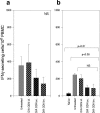Prevention and treatment of cutaneous leishmaniasis in primates by using synthetic type D/A oligodeoxynucleotides expressing CpG motifs
- PMID: 16041009
- PMCID: PMC1201230
- DOI: 10.1128/IAI.73.8.4948-4954.2005
Prevention and treatment of cutaneous leishmaniasis in primates by using synthetic type D/A oligodeoxynucleotides expressing CpG motifs
Abstract
Oligodeoxynucleotides (ODN) containing CpG motifs mimic microbial DNA and are recognized by toll-like receptor 9 on immune cells. The resulting response limits the early spread of infectious organisms and promotes the development of adaptive immunity. In this regard, CpG ODN show promise as immunoprotective agents and as vaccine adjuvants. Previous studies of nonhuman primates showed that administration of CpG ODN type D (also known as type A) at the site of infection 3 days before and after a challenge with Leishmania major enhanced host resistance and reduced the lesion's severity. In this study, we show that systemic administration of D/A ODN limits the size of lesions following an intradermal infection with L. major. Importantly, the reduced morbidity was not associated with a reduction in long-term immunity, as such treated macaques were still protected following a secondary challenge. Finally, administration of D/A ODN to macaques that had established cutaneous lesions reduced the severity of the lesions, suggesting a potential role for CpG ODN in L. major treatment. Together, these findings support the development of clinical studies to assess the use of CpG ODN types D/A as immunoprotective and therapeutic agents.
Figures







References
-
- Amaral, V. F., V. A. O. Ransatto, F. Conceicao-Solva, E. Molinaro, V. Ferreira, S. G. Coutinho, D. McMahon-Pratt, and G. Grimaldi. 1996. Leishmania amazonensis: the Asian rhesus macaques (macaca mulata) as an experimental model for the study of cutaneous leishmaniasis. Exp. Parasitol. 82:34-44. - PubMed
-
- Amaral, V. F., A. Teva, R. Porrozzi, A. J. Silva, M. S. Pereira, M. P. Oliveira-Neto, and G. Grimaldi, Jr. 2001. Leishmania major-infected rhesus macaques (Macaca mulatta) develop varying levels of resistance against homologous re-infections. Mem. Inst. Oswaldo Cruz 96:795-804. - PubMed
MeSH terms
Substances
LinkOut - more resources
Full Text Sources
Other Literature Sources

